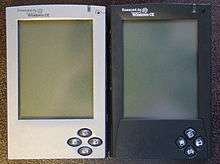Palm-size PC
The Palm-Size PC (formerly known as Palm PC) was Microsoft's first attempt at a computer conforming to an 'in your hand' profile. The platform was phased out in 2000.
Information
These devices demonstrated many firsts for this form factor, including comparatively high-resolution screens with later versions even having colour displays and a standardized software environment that ran on licensed OEM hardware platforms.
Early Palm-size PCs used SH3 and MIPS microprocessors. An x86 build environment—better referred to as x86EM—was available for the purpose of IDE build debugging through the PsPC 1.2 development SDK, but was not available on a commercial level inside devices. Palm-size PCs held similarities with their older cousins the Handheld PC in terms of GUI (closely resembling the Windows 95 desktop) and underlying kernel subsystems. The Palm-size PC was based upon either Windows CE 2.01 or 2.11 core.
James Bond sported a HP Jornada 430se in the 1999 film The World Is Not Enough.[1]
Legacy
The Palm-Size PC was never hugely successful, largely due to the price range and lack of connectivity options when compared to their Handheld PC counterparts. Microsoft later refreshed the release into a more distinctive package as the Pocket PC and would later ultimately abandon the MIPS and/or SH3 architectures in favor of the ARM architecture.
Microsoft's original name for the device was Palm PC, however this provoked a lawsuit from Palm Inc. for infringing their trademark. Microsoft was subsequently forced to change the name to Palm-sized PC. The platform was phased out in 2000, in favour of the Pocket PC line of handhelds running Windows Mobile.
See also
- ActiveSync - Application for synchronizing hand-held devices and Windows PCs
- Handheld PC - The predecessor of Palm-sized PCs.
- Pocket PC - The successor of Palm-sized PCs.
- Windows CE - Operating system of Palm-sized PCs.
- Windows Mobile - Operating system of Pocket PCs.
- HP Jornada - A line of Handheld, Palm-size and Pocket PCs.
- Philips Nino - A line of Palm-size PCs
References
External links
- HPC:Factor — History of Windows CE
